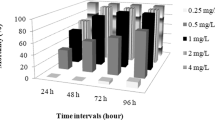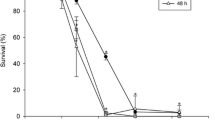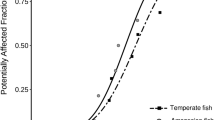Abstract
Bioassay studies have been conducted with chlordane (an organochlorine compound), and Ekatin®, Ekalaux®, and Sumithion® (organophosphorous compounds) to determine the LC50, acute toxicities, relative toxicities, presumable harmless concentrations, and dilution volumes for a period of 24-, 48-, 72-, and 96-hr to a fresh water teleostSaccobranchus fossilis. The 24-, 48-, 72-, and 96-hr LC50 for chlordane, Ekalaux, Ekatin, and Sumithion are 0.54, 0.49, 0.46, and 0.42 mg/L; 2.75, 2.40, 1.75, and 1.55 mg/L; 12.40, 12.10, 11.75, and 11.00 mg/L; and 14.90, 14.20, 13.75, and 12.50 mg/L, respectively. Presumable harmless concentrations are 0.12, 0.55, 3.46, and 3.87 mg/L, respectively, which are a fraction of LC50 values. The relative toxicities of these pesticides calculated on the basis of 24-hr LC50 to the fish are 27.59, 5.42, 1.20, and 1.00 for chlordane, Ekalaux, Ekatin, and Sumithion, respectively. The acute toxicity for Sumithion to the test fish lies between 12.10 and 18.75 mg/L, for chlordane between 0.37 and 0.75 mg/L, for Ekatin between 10.00 and 14.20 mg/L, and for Ekalaux between 1.35 and 3.25 mg/L. It is concluded from the study that chlordane is the most toxic and Sumithion is the least toxic while the toxicities of Ekatin and Ekalaux lie between the two. When the data for survival of the test fishvs. log concentration are plotted, they exhibit a linear relationship following the formula Y= ¯Y+b(X−¯X). The presumable harmless concentrations can be utilized on broad lines for controlling short-term water pollution by these pesticides.
Similar content being viewed by others
References
Anderson, J. M.: Effect of sublethal concentration of DDT on the lateral line of brook trout,Salvelinus fontinalis. J. Fish Res. Bd. Can.25, 2677 (1968).
Dalela, R. C., S. R. Verma, and M. C. Bhatnagar: Biocides in relation to water pollution. I. Bioassay studies of few biocides to fresh water fish,Channa gachua. Acta Hydrochim. et. Hydrobiol. Accepted for publication (1976).
Hart, W. B., P. Doudoroff, and J. Greenbank: The evaluation of the toxicity of industrial wastes, chemicals and other substances to fresh water fish. Atlantic Refining Co. Phil.317, (1945).
Ohio River Valley Water Sanitation Commission, Cincinnati, Ohio; Aquatic Life Advisory Committee, First Progress report. Sew. and Ind. Wastes.27, 321 (1955).
Pantulu, V. R.: Pollution of rivers by industrial effluent and its effects on fisheries. 2nd Anniversary Commemoration Volume of theIndian Association of Water and Water Pollution Control, Nagpur (India),100, Dec. 1965.
Snedecor, G. W.: Statistical Methods, Allied Pacific Pvt. Ltd., Bombay (1960).
Sprague, J. B.: Review paper: Measure of pollutant toxicity to fish I. Bioassay methods for acute toxicity. Water Research3, 793 (1969).
Standard Methods for the Examination of Water and Waste Water, 13th Edition, APHA, AWWA and WPCF, New York (1971).
Verma, S. R., S. P. Gupta, R. C. Dalela, and M. P. Tyagi: Studies on the toxicity of DDT on fresh water teleost fishes. Part I. TLm measurement and accumulation of DDT in liver and intestine ofColisa fasciatus andNotopterus notopterus. Gegenbaurs Morph. Johrb. Leipzig.120, 439 (1974).
Verma, S. R., S. P. Gupta, and M. P. Tyagi: Studies on the toxicity of lindane onColisa fasciatus (Part I. TLm measurements and histopathological changes in certain tissues). Gegenbaurs Morph. Johrb. Leipzig.121, 38 (1975).
Verma, S. R., M. C. Bhatnagar, and R. C. Dalela: Biocides in relation to water pollution. II. Bioassay studies of few biocides to fresh water fishChanna gachua. Acta Hydrochim. et. Hydrobiol. In press (1976).
Verma, S. R., S. K. Bansal, and R. C. Dalela: Bioassay trials with few organic biocides to a fresh water fish,Labeo rohita. Indian J. Environ. Hlth.19, 107 (1977).
Warren, C. E.: Biology and Water Pollution Control. W. B. Saunders Company, London WCIA (1971).
Author information
Authors and Affiliations
Rights and permissions
About this article
Cite this article
Verma, S.R., Bansal, S.K. & Dalela, R.C. Toxicity of selected organic pesticides to a fresh water teleost fish,Saccobranchus fossilis and its application in controlling water pollution. Arch. Environ. Contam. Toxicol. 7, 317–323 (1978). https://doi.org/10.1007/BF02332059
Received:
Accepted:
Issue Date:
DOI: https://doi.org/10.1007/BF02332059




